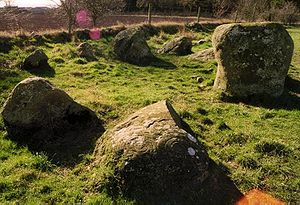Little Meg: Difference between revisions
Created page with "right|thumb|300px|The Little Meg circle behind the decorated stone {{county|Cumberland}} '''Little Meg''' (also known as the 'Maughanby circle') is a..." |
|||
| Line 9: | Line 9: | ||
==Location== | ==Location== | ||
*Location map: {{wmap|54.73064|-2.65845|zoom=14}} | *Location map: {{wmap|54.73064|-2.65845|zoom=14}} | ||
*OS map: {{ | *OS map: {{map|NY57693749}} | ||
Little Meg is situated 710 yards north-east of the Long Meg stone circle ({{map|NY57693749}}). It stands on a very slight ridge amongst gently undulating glacial deposits.<ref>{{Cite book|last=Clare|first=Tom|title=Prehistoric monuments of the Lake District|location=Stroud|publisher=Tempus|year=2007|pages=1-159, p.48|ISBN=9780752441054}}</ref> Long Meg would have been visible at the time of its use. | Little Meg is situated 710 yards north-east of the Long Meg stone circle ({{map|NY57693749}}). It stands on a very slight ridge amongst gently undulating glacial deposits.<ref>{{Cite book|last=Clare|first=Tom|title=Prehistoric monuments of the Lake District|location=Stroud|publisher=Tempus|year=2007|pages=1-159, p.48|ISBN=9780752441054}}</ref> Long Meg would have been visible at the time of its use. | ||
Latest revision as of 17:16, 21 July 2017

Little Meg (also known as the 'Maughanby circle') is a small, Bronze Age stone circle close to the village of Langwathby to the north-east of Penrith in Cumberland.
The circle is made of large kerb stones which probably surrounded a Bronze Age kerb cairn. It is 700 yards north-east of the more famous stone circle known as Long Meg and Her Daughters, and forms part of a complex of stone circles and cairns around the Long Meg site that includes the circle at Glassonby, Old Parks, and other sites since lost.
Two of the stones (of which only one remains) were decorated in antiquity with a series of concentric circles and a spiral.
Location
- Location map: 54°43’50"N, 2°39’30"W
- OS map: NY57693749
Little Meg is situated 710 yards north-east of the Long Meg stone circle (NY57693749). It stands on a very slight ridge amongst gently undulating glacial deposits.[1] Long Meg would have been visible at the time of its use.
The stone circles, henges, cairns and other standing stones in the area are often grouped at nodes of communication routes. The Shap Stone Avenue to the south of Penrith, forms an 'avenue' running to the east of the River Lowther along a main route to the north; the Long Meg complex runs alongside the River Eden; Mayburgh and the other henges run alongside the River Eamont near its confluence with the River Lowther.
Among the many questions related to this site, one concerns why Little Meg was not aligned with the midwinter or midsummer line to Long Meg. Clare suggests that maybe that line was considered too 'sacred', or that the existing vegetation precluded seeing the line, or that there was already another monument there.[2]
Construction
Other questions concern the nature of the construction of Little Meg. When first discovered in the middle of the nineteenth century, there was a mound of about 4 feet covering the stones. The number of stones was reported to be 8 by one person, 11 by another, perhaps because the mound was not completely cleared away and still covered three stones. Bones, charcoal and a 'coarse pot' were found buried in a cist at the centre of the circle, the pot being unadorned and standing at the east end of the cist.[3]
Whether the stones were actually standing or lying down is also another question. It is possible that some stones were pushed over prior to the building of the mound.[4]
Given an 11-stone circle, about 18 feet in diameter, it might be that the internal cairn was part of the original structure.[5]
Rock art
There is one boulder existing today that has a spiral on it linked into multiple concentric circles.[6] The crispness of the cutting may suggest that the work was done shortly before the mound was made, thus preserving the artwork.[7] There was another stone at the west side of the circle, no longer extant, that had an incised circle and other markings on it.
Two stones found in the cist (one of which is now in the Penrith Museum), have cup and ring markings. Their use in the cist is uncertain - they may have supported a cap stone. The markings on the cist stone are cup-centred, whereas the ones on the ring-stones are on a plain background, suggesting that the cist itself was a later addition.
Dating and purpose
Although Little Meg looks like a small stone circle or oval, it is more likely to be a Bronze Age (c.2,500 - c.700 B.C.) kerb cairn. Another cairn was reported 100 yards to the east of Little Meg by the original recorder of Little Meg itself, Canon Simpson.[8]
Outside links
| ("Wikimedia Commons" has material about Little Meg) |
References
- ↑ Clare, Tom (2007). Prehistoric monuments of the Lake District. Stroud: Tempus. pp. 1-159, p.48. ISBN 9780752441054.
- ↑ Clare, 2007, p.50
- ↑ Clare, 2007, p.48
- ↑ Clare, 2007, p.49
- ↑ Beckensall, Stan: 'Prehistoric rock art in Cumbria: landscapes and monuments' pages 1-160, 81 (Tempus, 2002) ISBN 9780752425269
- ↑ Beckensall, 2002, p.81
- ↑ Clare, 2007, p.49
- ↑ Clare, 2007, p.50
